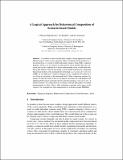Files in this item
A logical approach for behavioural composition of scenario-based models
Item metadata
| dc.contributor.author | Bowles, Juliana Kuster Filipe | |
| dc.contributor.author | Bordbar, Behzad | |
| dc.contributor.author | Alwanain, Mohammed | |
| dc.contributor.editor | Butler, Michael | |
| dc.contributor.editor | Conchon, Sylvain | |
| dc.contributor.editor | Zaïdi, Fatiha | |
| dc.date.accessioned | 2016-12-02T00:34:07Z | |
| dc.date.available | 2016-12-02T00:34:07Z | |
| dc.date.issued | 2015 | |
| dc.identifier | 202057645 | |
| dc.identifier | 75281ce6-6ba4-48fa-9203-2ae407aa3319 | |
| dc.identifier | 84949267489 | |
| dc.identifier.citation | Bowles , J K F , Bordbar , B & Alwanain , M 2015 , A logical approach for behavioural composition of scenario-based models . in M Butler , S Conchon & F Zaïdi (eds) , Formal Methods and Software Engineering : 17th International Conference on Formal Engineering Methods, ICFEM 2015, Paris, France, November 3-5, 2015, Proceedings . Lecture Notes in Computer Science , vol. 9407 , Springer , Cham , pp. 252-269 , ICFEM 2015 The 17th International Conference on Formal Engineering Methods , Paris , France , 3/11/15 . https://doi.org/10.1007/978-3-319-25423-4_16 | en |
| dc.identifier.citation | conference | en |
| dc.identifier.isbn | 9783319254227 | |
| dc.identifier.isbn | 9783319254234 | |
| dc.identifier.issn | 0302-9743 | |
| dc.identifier.other | ORCID: /0000-0002-5918-9114/work/58055302 | |
| dc.identifier.uri | https://hdl.handle.net/10023/9924 | |
| dc.description.abstract | As modern systems become more complex, design approaches model different aspects of the system separately. When considering (intra and inter) system interactions, it is usual to model individual scenarios using UML’s sequence diagrams. Given a set of scenarios we then need to check whether these are consistent and can be combined for a better understanding of the overall behaviour. This paper addresses this by presenting a novel formal technique for composing behavioural models at the metamodel level through exact metamodel restriction (EMR). In our approach a sequence diagram can be completely described by a set of logical constraints at the metamodel level. When composing sequence diagrams we take the union of the sets of logical constraints for each diagram and additional behavioural constraints that describe the matching composition glue. A formal semantics for composition in accordance with the glue guides our model transformation to Alloy. Alloy’s fully automated constraint solver gives us the solution. Our technique has been implemented as an Eclipse plugin SD2Alloy. | |
| dc.format.extent | 17 | |
| dc.format.extent | 290641 | |
| dc.language.iso | eng | |
| dc.publisher | Springer | |
| dc.relation.ispartof | Formal Methods and Software Engineering | en |
| dc.relation.ispartofseries | Lecture Notes in Computer Science | en |
| dc.subject | Sequence diagrams | en |
| dc.subject | Behavioural composition | en |
| dc.subject | Event structures | en |
| dc.subject | Alloy | en |
| dc.subject | QA75 Electronic computers. Computer science | en |
| dc.subject | NDAS | en |
| dc.subject.lcc | QA75 | en |
| dc.title | A logical approach for behavioural composition of scenario-based models | en |
| dc.type | Conference item | en |
| dc.contributor.institution | University of St Andrews. School of Computer Science | en |
| dc.identifier.doi | https://doi.org/10.1007/978-3-319-25423-4_16 | |
| dc.date.embargoedUntil | 2016-12-01 | |
| dc.identifier.url | http://www.springer.com/us/book/9783319254227 | en |
This item appears in the following Collection(s)
Items in the St Andrews Research Repository are protected by copyright, with all rights reserved, unless otherwise indicated.

